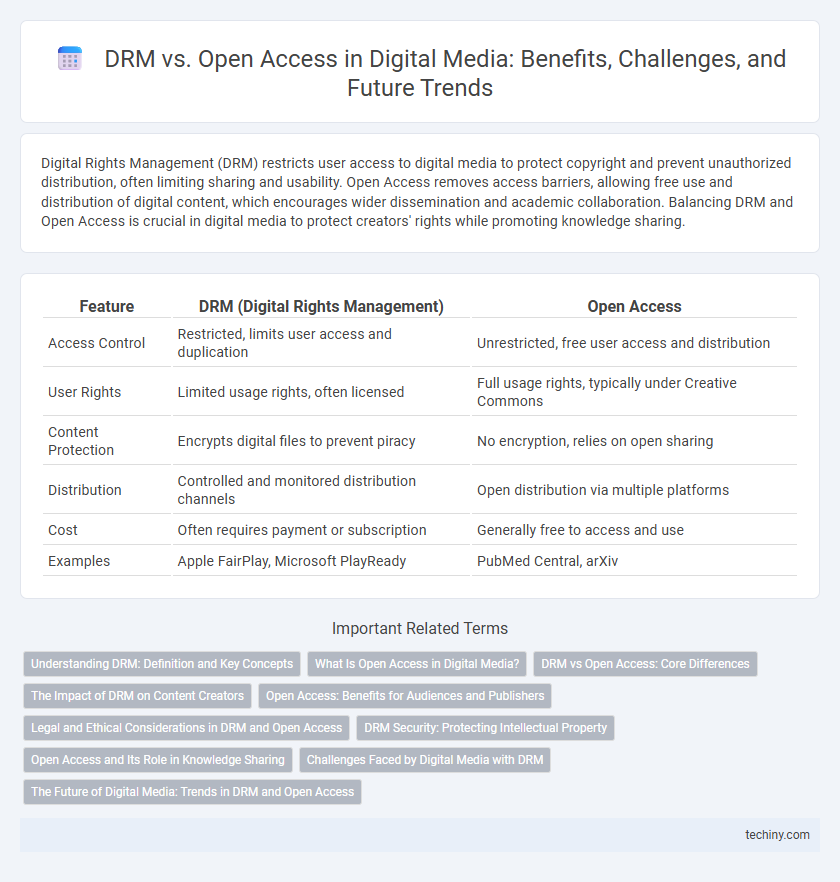Digital Rights Management (DRM) restricts user access to digital media to protect copyright and prevent unauthorized distribution, often limiting sharing and usability. Open Access removes access barriers, allowing free use and distribution of digital content, which encourages wider dissemination and academic collaboration. Balancing DRM and Open Access is crucial in digital media to protect creators' rights while promoting knowledge sharing.
Table of Comparison
| Feature | DRM (Digital Rights Management) | Open Access |
|---|---|---|
| Access Control | Restricted, limits user access and duplication | Unrestricted, free user access and distribution |
| User Rights | Limited usage rights, often licensed | Full usage rights, typically under Creative Commons |
| Content Protection | Encrypts digital files to prevent piracy | No encryption, relies on open sharing |
| Distribution | Controlled and monitored distribution channels | Open distribution via multiple platforms |
| Cost | Often requires payment or subscription | Generally free to access and use |
| Examples | Apple FairPlay, Microsoft PlayReady | PubMed Central, arXiv |
Understanding DRM: Definition and Key Concepts
Digital Rights Management (DRM) refers to technologies and protocols that control the use, modification, and distribution of digital content to protect intellectual property rights. DRM systems often include encryption, access controls, and usage restrictions to prevent unauthorized copying and sharing. Understanding DRM involves recognizing its role in enforcing licensing agreements and balancing creators' rights with consumer access in the digital media landscape.
What Is Open Access in Digital Media?
Open Access in digital media refers to unrestricted online access to content without paywalls, enabling free sharing and distribution of digital works such as articles, videos, and music. This model promotes wider dissemination, enhances visibility, and allows creators to reach broader audiences while easing digital rights management complexities. Open Access contrasts with DRM-protected content by removing usage barriers, encouraging collaboration, and supporting educational and cultural innovation.
DRM vs Open Access: Core Differences
Digital Rights Management (DRM) restricts access to digital media through encryption and licensing to prevent unauthorized copying and distribution, ensuring content creators retain control over their work. Open Access, in contrast, allows free and unrestricted access to digital content, promoting wider dissemination and use without legal or technical barriers. The core difference lies in DRM's enforcement of content protection versus Open Access's emphasis on accessibility and sharing.
The Impact of DRM on Content Creators
Digital Rights Management (DRM) restricts how content creators distribute and monetize their digital media, often limiting audience reach and creative freedom. Open Access models empower creators by removing barriers to content sharing, increasing visibility and fostering innovation. The balance between DRM enforcement and open access strategies significantly affects revenue streams and audience engagement for digital media producers.
Open Access: Benefits for Audiences and Publishers
Open Access in digital media enhances audience reach by removing paywalls, enabling unrestricted access to content and promoting knowledge equity globally. Publishers benefit from increased visibility, higher citation rates, and broader dissemination of their work, fostering a more engaged and diverse readership. This model supports sustainable content sharing while reducing piracy and enhancing the digital footprint of both established and emerging creators.
Legal and Ethical Considerations in DRM and Open Access
Digital Rights Management (DRM) enforces copyright protection by restricting unauthorized access and copying of digital media, safeguarding content creators' legal rights but raising ethical concerns about user autonomy and fair use. In contrast, Open Access promotes unrestricted public access to digital content, enhancing knowledge dissemination and ethical transparency while challenging traditional copyright enforcement and potential revenue models. Balancing legal frameworks with ethical considerations is crucial to developing sustainable digital media practices that protect intellectual property without hindering information accessibility.
DRM Security: Protecting Intellectual Property
Digital Rights Management (DRM) systems enforce strict access controls and encryption to protect intellectual property from unauthorized copying and distribution in digital media. DRM security protocols ensure that content creators and distributors maintain control over usage rights, preventing piracy and preserving revenue streams. Advanced DRM technologies integrate watermarking, license validation, and device authentication to safeguard digital assets across various platforms.
Open Access and Its Role in Knowledge Sharing
Open Access accelerates knowledge dissemination by removing paywalls and providing unrestricted access to digital media content, fostering global collaboration and innovation. It enhances academic visibility and citation rates, supporting equitable education and research opportunities across diverse disciplines. This model challenges traditional DRM by prioritizing user rights and promoting transparent information exchange.
Challenges Faced by Digital Media with DRM
Digital Rights Management (DRM) in digital media faces significant challenges including user accessibility restrictions, which often lead to consumer dissatisfaction and potential piracy. Content creators and distributors struggle with balancing protection against unauthorized use and providing seamless user experiences. Moreover, DRM implementation can hinder content interoperability across different platforms and devices, limiting audience reach and engagement.
The Future of Digital Media: Trends in DRM and Open Access
Emerging trends in digital media indicate a shift towards balancing Digital Rights Management (DRM) with Open Access models to enhance user experience while protecting intellectual property. Advances in blockchain technology and decentralized licensing systems are redefining DRM frameworks, enabling more transparent and flexible rights management. Open Access initiatives continue to gain momentum, promoting wider distribution and collaboration, especially in educational and scientific digital content sectors.
DRM vs Open Access Infographic

 techiny.com
techiny.com